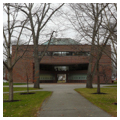Located in Brunswick, Maine, and founded in 1794, Bowdoin College originated from the petition of residents of the Maine District of Massachusetts for a college in closer proximity than Harvard. The City of Portland and residents of Kennebec Valley compromised on the Brunswick location. Originally a quasi-public/private institution historically linked to the Congregational Church, Bowdoin was declared private in 1833. Bowdoin’s historic quadrangle presents an impressive mix of nineteenth-century revivalist styles as well as modernist buildings.
The first buildings on campus define the present-day quadrangle’s northeastern boundary. Massachusetts Hall (1802) and Maine Hall (1808) were brick buildings completed in the Federal style by local housewrights Samuel Melcher III and his brother Aaron. Massachusetts Hall served several purposes for the fledgling college: president’s house, students’ residence, chapel, library, and classroom. With a couple years, however, a frame chapel and library (1805) were completed, as was Maine Hall, the new dormitory. A president’s house was also completed around this time on the west side of the quad, although the Gothic Revival Mary Frances Searles Science Building (1894, Henry Vaughan) now occupies that location.
With the construction of Memorial Hall in 1867–1882, the quadrangle had begun to take shape. Architects Samuel D. Backus and William G. Preston designed a French Gothic Revival structure to house a lecture hall, two classrooms, and a large meeting hall. In 1955, the firm McKim, Mead and White remodeled Memorial Hall into the Pickard Theater.
Bowdoin’s twin-towered, Romanesque Revival chapel (1845–1855), designed by British-born Richard Upjohn, occupies the eastern side of the quadrangle, with two residence halls located on either side. When Maine Hall was ravaged by fire in 1822, Bowdoin asked Anthony Coombs Raymond to rebuild it in the design of the Melchers’ Winthrop Hall (1824), a four-story, Federal building not unlike Massachusetts Hall. The remaining east side residence halls, Appleton (1843) and Hyde (1917), are Greek Revival in style and, like Winthrop Hall, are named for Bowdoin presidents.
Henry Vaughan’s 1903 Hubbard Hall marks the southern boundary of the quadrangle. Its Gothic Revival design was meant to embody Bowdoin’s new emphasis on scientifically inspired German scholarship. Rounding out the quadrangle to the west, in addition to the Searle Science Building, are the Walker Art Building (1894; 2007 renovation, Machado and Silvetti) and the Gibson Hall of Music (1954), and the modernist Visual Arts Center (1975, Edward Larrabee Barnes).
In 1994 Bowdoin College launched a capital campaign to support new construction and renovation of buildings such as Searle Hall and Memorial Hall (Pickard Theater). Other major projects included a $20.8 million renovation and expansion of the Bowdoin College Museum of Art, as well as a $15 million renovation of the Curtis Pool building (1927, McKim, Mead and White) into the Studzinski Recital Hall and Kanbar Auditorium, completed in 2007.
References
Anderson, Patricia McGraw. The Architecture of Bowdoin College.Brunswick, ME: Bowdoin College Museum of Art, 1988.





















